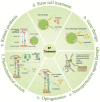Retinitis Pigmentosa: Progress in Molecular Pathology and Biotherapeutical Strategies
- PMID: 35563274
- PMCID: PMC9101511
- DOI: 10.3390/ijms23094883
Retinitis Pigmentosa: Progress in Molecular Pathology and Biotherapeutical Strategies
Abstract
Retinitis pigmentosa (RP) is genetically heterogeneous retinopathy caused by photoreceptor cell death and retinal pigment epithelial atrophy that eventually results in blindness in bilateral eyes. Various photoreceptor cell death types and pathological phenotypic changes that have been disclosed in RP demand in-depth research of its pathogenic mechanism that may account for inter-patient heterogeneous responses to mainstream drug treatment. As the primary method for studying the genetic characteristics of RP, molecular biology has been widely used in disease diagnosis and clinical trials. Current technology iterations, such as gene therapy, stem cell therapy, and optogenetics, are advancing towards precise diagnosis and clinical applications. Specifically, technologies, such as effective delivery vectors, CRISPR/Cas9 technology, and iPSC-based cell transplantation, hasten the pace of personalized precision medicine in RP. The combination of conventional therapy and state-of-the-art medication is promising in revolutionizing RP treatment strategies. This article provides an overview of the latest research on the pathogenesis, diagnosis, and treatment of retinitis pigmentosa, aiming for a convenient reference of what has been achieved so far.
Keywords: cell death; gene therapy; induced pluripotent stem cells; optogenetics; retinal remodeling; retinitis pigmentosa (RP).
Conflict of interest statement
The authors declare that the research was conducted in the absence of any commercial or financial relationships that could be construed as a potential conflict of interest.
Figures






References
-
- Michalakis S., Koch S., Sothilingam V., Garcia Garrido M., Tanimoto N., Schulze E., Becirovic E., Koch F., Seide C., Beck S.C., et al. Gene therapy restores vision and delays degeneration in the CNGB1(-/-) mouse model of retinitis pigmentosa. Adv. Exp. Med. Biol. 2014;801:733–739. doi: 10.1007/978-1-4614-3209-8_92. - DOI - PubMed
Publication types
MeSH terms
Grants and funding
LinkOut - more resources
Full Text Sources
Research Materials

